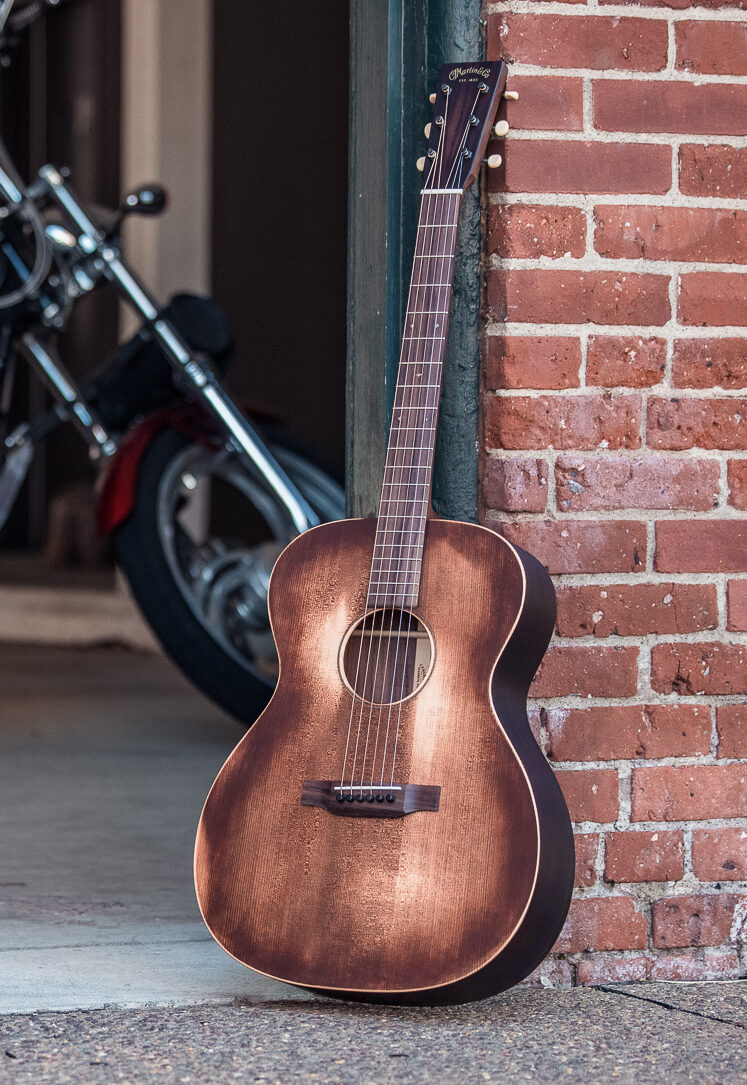The 000-16 StreetMaster brings Adirondack spruce to the 16 Series
First use of VTS on an “affordable” Martin guitar
Specs of the 000-16 StreetMaster include: Auditorium 000 size; all-solid tonewoods including Indian rosewood back and sides, Adirondack spruce soundboard with Vintage Tone System torrefaction, and 5/16″ scalloped braces; short-scale High Performance neck with Modified Low Oval profile; Indian rosewood fingerboard with 1-3/4″ width at nut, 2-1/8th at 12th fret, short pattern Diamond and Squares position markers; Indian rosewood bridge with 2-5/32″ string spacing at the bone saddle; StreetMaster distressed satin finish; open gear Golden Age Relic tuning machines with cream buttons; soft shell case.
“The VTS Adirondack spruce helps make the 000-16 StreetMaster sound bright and expressive to the point of effervescent, yet it has a warm heart, thanks to the rosewood back and sides.”
The First 16 Series StreetMaster
The Martin 000-16 StreetMaster is a 000-size acoustic guitar with special features never before seen in the 16 Series, including the visually eye-catching StreetMaster cosmetic finish, and an Adirondack spruce top that underwent Martin’s proprietary torrefaction treatment, which they call their Vintage Tone System. These 16 Series firsts make it one of the more fascinating acoustic guitars released by anyone in 2022.
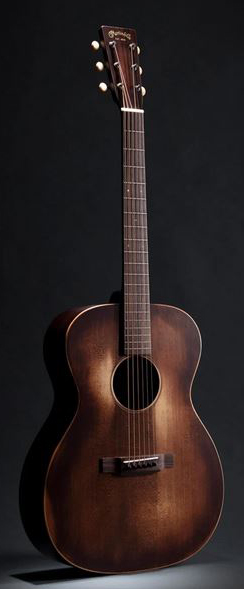 I enjoyed the 000-16 StreetMaster at the first strum. I was impressed with how alive and projecting the voice was from even the lightest stroke of a pick and how much pop and vitality there is when played with vigor. It provides an unusual combination of crispy brightness and deeper woody warmth, which I guess should not be that surprising, given the tonewoods and construction techniques used to create it.
I enjoyed the 000-16 StreetMaster at the first strum. I was impressed with how alive and projecting the voice was from even the lightest stroke of a pick and how much pop and vitality there is when played with vigor. It provides an unusual combination of crispy brightness and deeper woody warmth, which I guess should not be that surprising, given the tonewoods and construction techniques used to create it.
The VTS Adirondack spruce helps make the 000-16 StreetMaster sound bright and expressive to the point of effervescent, yet it has a warm heart, thanks to the rosewood back and sides. The voice has an open and airy quality and yet that space is pregnant with a darker if ethereal presence, what I sometimes call that Martin smoky rosewood undertone.
The openness is due at least partly to the VTS torrefaction. The spruce top was exposed to heat and pressure that would have incinerated it to charcoal if it weren’t inside an oxygen-free kiln. This roasting process crystalized the cellular interiors to the point that a microscope shows them looking just like Adirondack spruce that had dried over some 90 years. This also accounts for that crisp pop to the fundamental notes.
Even with the rosewood body, the combination of a light satin finish, the simple dovetail neck joint, and the rosewood fingerboard and bridge help create tonal dynamics that seem akin to a 17 Series model more than other Martins in the 16 Series. But because of the rosewood body, their is a lot more going on in terms of soaring overtones and meaty undertone.
In fact, the 000-16 StreetMaster has much of same styling of a 15 Series instrument. It has no binding or purfling inlaid around the top or back, but it does have the diamond fingerboard markers, the vintage Martin head stock logo, and the Golden Age Relic turning machines, a motif I have loved since it was first appeared on the 15 Series in 2010.
But this new 16 StreetMaster 000 has the short-scale High Performance neck with its 1-3/4″ nut width, rather than the long scale neck and 1-11/16″ nut width of a 000-15M. So, it is a bit of a hybrid. Since it isn’t made with mahogany for the body or the top, they wisely decided to not call this new model something like a “000-15 StreetMaster Special,” even if the tonewoods make this new Martin rather special indeed.
Street Wise
The vaguely Springsteenian “StreetMaster” is said to be Martin’s “respectful nod to the performing musician.” Apparently, Martin sees the unusual finish treatment as evocative of street buskers and other journeymen players whose guitar has seen a lot of duty out in the world, to the point that it has developed a dark patina on its aging finish, or lots of wear and tear of playing on the sidewalks or while traveling the highways and byways of America. But unlike Martin’s Aged models, which are truly physically distressed with dings and scrapes and worn away lacquer, the StreetMaster finish is but a matter of looks, with its rusted darkness being lightened up here and there.
This provides contrasted color variation in seemingly random patches and swaths, while the thin satin lacquer allows the grain of the wood to influence the visual textures of the lighter parts. But it is not actually random. It is artistically and carefully thought out. There is boldness in the concept and wisdom in its realization.
click to enlarge
 |
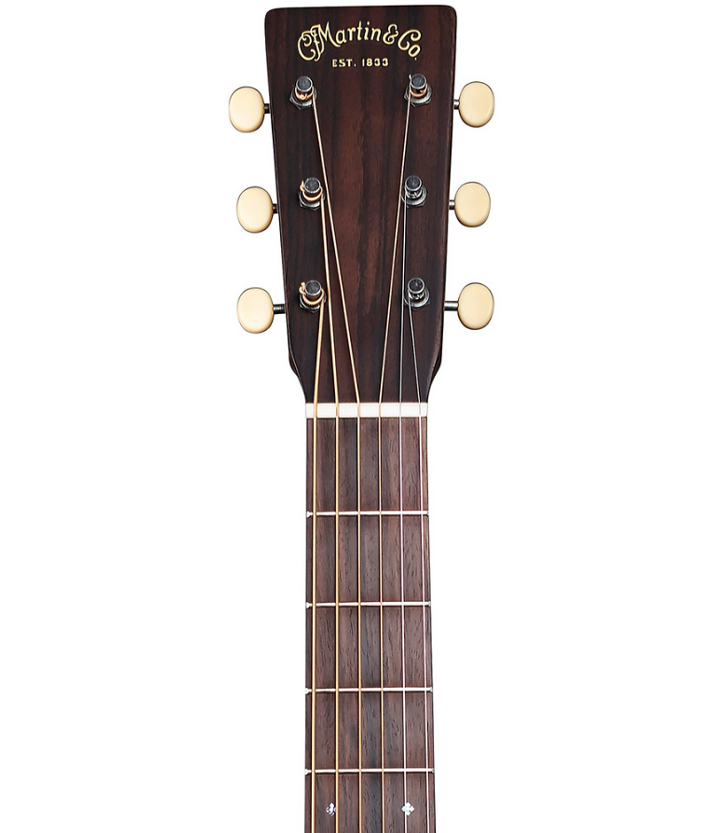 |
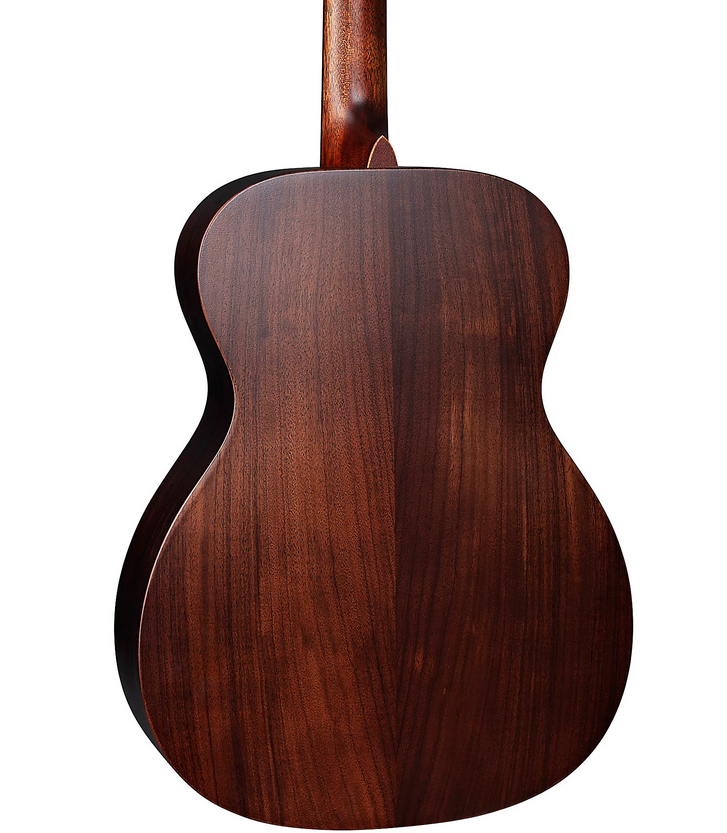 |
This finishing technique was developed to liven up the looks of the all-mahogany guitars in the 15 Series that have the monotone color pallet of a Brazil nut. With the 000-16 StreetMaster we have the first use of this finishing application on a spruce top, which seems even more artistically achieved to my eye.
While the 000-15M StreetMaster has lighter and darker patches with some visual dynamics, the 000-16 StreetMaster is more dramatic in its appearance. It is like the guitar comes with its own display lamps splashing pools of light here and there across the soundboard and the back of the neck, while highlighting the sound hole and the edge of the spruce soundboard in a way that suggests purfling or binding where there isn’t any.
Awesome Adirondack
The 000-16 StreetMaster stands apart not only because of the artistically distressed satin finish. Beneath that rusty, brassy look is solid Adirondack spruce, which was the primary wood used for Martin from the 1830s through the 1930s.
Adirondack spruce offers high velocity projection that works well with the slower bloom of rosewood’s undertone and harmonic overtones. The combination creates the sound effect of ever-expanding tone. The rest of the 16 and 17 Series have tops of Sitka or Lutz spruce, as do all models in Standard Series and Modern Deluxe Series. This makes the 000-16 StreetMaster the most affordable Martin guitar made with Adirondack spruce by far.
Sitka and Lutz sound warmer and fuller in terms of the low-mids and mid-range. But Adirondack shows off a deeper bass, because it is so transparent that it allows the tonal character of the rosewood back and sides woods to be perceived clearly to the bottom of the deepest cellar.
Happy Accident
There is a practical reason Martin decided to introduce VTS Adirondack spruce on such a relatively affordable model and then applied the arresting StreetMaster finish treatment to it. The high heat of the VTS treatment can change the color of spruce in uneven ways, similar to a piece of toasted bread. But at times, the sugar deposits in the wood grain can darken considerably, similar to how a confectioner’s torch blackens the top of crème brulée.
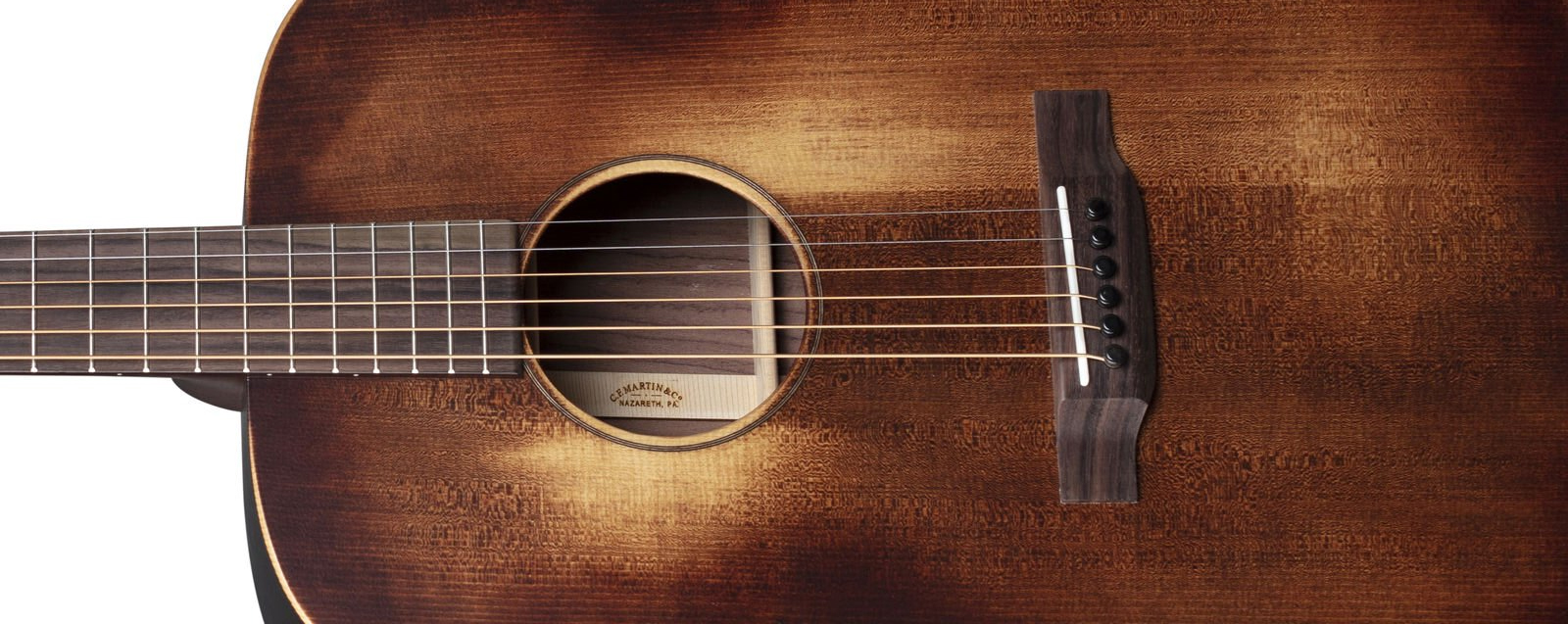 As a result, some VTS Adirondack spruce ends up aesthetically inappropriate for the vintage Martin recreations in the exclusive Authentic Series. This made available a growing supply of excellent Adi that looked a little odd.
As a result, some VTS Adirondack spruce ends up aesthetically inappropriate for the vintage Martin recreations in the exclusive Authentic Series. This made available a growing supply of excellent Adi that looked a little odd.
The StreetMaster finishing techniques proved a tasteful cover up for some of the toastier VTS tops. This is a similar strategy seen with Martin’s sunburst finishes that often employ Sitka spruce with visual anomalies that go unnoticed under the dark toner of a 1935 Burst or Amberburst finish.
Sweet 16
Typical Martin molds were often broken in the 16 Series and this new 000-16 StreetMaster has gone and broken 16 Series molds. It has no pickup system for one thing, when the 16 Series had evolved into acoustic-electric models for stage and studio work. It is a short-scale 000, like those made in the 1930s, when previous 000-16s were made with long-scale necks since they first appeared in the 1980s. While certain 16s had rosewood back and sides, none had Adirondack spruce, let along VTS Adirondack spruce.
Style 16 was invented in 1961 when the 0-16 New York model brought back nineteenth century design elements. But when Martin returned to Style 16 in 1986 it became synonymous with forward-thinking experimentation, but always inspired by Martin’s storied past. This included features like the Martin’s first adjustable neck rod, introduced with the first Low Profile necks, on the D-16 and 000-16, models that also had vintage-style scalloped braces at a time when standard Martins were still using non-scalloped bracing. When the D-18 and 000-18 had black binding and a black pickguard, the D-16, 000-16, and 000C-16 had faux tortoise bindings and pickguards. Martin also the D-16 with a back and sides of mahogany, but also offered it in alternative tonewoods like ash, walnut, maple, and koa.
The first long-scale 000s since 1934 were the 000-16 and 000-C16, essentially OMs with 1/4″ bracing, but a sleek 1-11/16″ Low Profile neck. In the late 1990s the 16s were the first Martins to have the Modified Low Oval, now the standard neck shape at Martin. At that point they added the first onboard electronic systems, and introduced the new mortise & tenon neck joint along with other non-traditional features designed to lower the price point compared to the legacy models that would soon make up the Standard Series.
In the twenty-first century, Martin developed the superior Simple Dovetail neck joint to replace the M&T joint on Martins made in Nazareth, PA in all series below the Standard Series. That also contributes to that substantial presence down inside the voice that says “Martin guitar.” Like the rosewood back and sides, VTS Adriondack spruce, thin, light satin finish, and rosewood bridge, they all play their part in the singular operetta that flies out of this nimble yet full sounding 000-16 StreetMaster, which sounds as unique as it looks. That is, until Martin releases future 16 Series StreetMaster models, which we must hoped they will sooner than later.
That is one man’s world on…
